In the ever-evolving landscape of compact SUVs, the SEAT Ateca and Skoda Karoq stand out as two formidable contenders. With both brands under the Volkswagen Group umbrella, these models share a wealth of technological advancements while maintaining their unique identities. In this comparison, we will delve into the technical specifications, performance, and notable innovations, shedding light on which SUV is the better choice for discerning buyers.
SEAT Ateca vs Skoda Karoq – Which model is better for everyday use?
Compare performance, boot capacity, efficiency and price at a glance.
Find out which car is the better choice for you – SEAT Ateca or Skoda Karoq?
Design and Dimensions
Both the SEAT Ateca and Skoda Karoq showcase striking designs that appeal to modern consumers. The Ateca measures 4381 mm in length, 1841 mm in width, and 1601 mm in height. Meanwhile, the Karoq is slightly longer, with dimensions of 4390 mm in length and varying heights of up to 1624 mm, enhancing its road presence.
The trunk capacity of the Ateca is rated at 510 liters, while the Karoq edges out with a slightly larger capacity of 521 liters, offering more space for luggage and essentials. This marginal difference could be a determining factor for potential buyers focused on practicality.
Powertrain Options
Under the hood, both the Ateca and Karoq offer a range of petrol and diesel engines. The Ateca comes with two primary engine options, namely the 1.0 TSI producing 116 HP and a more powerful 1.5 TSI delivering 150 HP. In contrast, the Karoq has a broader selection, including engines that generate 115 HP, 150 HP, and even a 190 HP variant, giving drivers more options depending on their performance needs.
Both models come equipped with front-wheel-drive configurations, but the Karoq also provides an all-wheel-drive option, catering to those who require better traction during adverse weather conditions or off-road scenarios.
Fuel Efficiency and Emissions
In terms of fuel efficiency, the SEAT Ateca offers competitive consumption figures ranging from 4.9 to 6.4 liters per 100 km, depending on the engine choice. The Skoda Karoq slightly outperforms its rival, with consumption figures ranging from 4.9 to 7.6 liters per 100 km. Both vehicles maintain respectable CO2 emissions ratings; the Ateca registers between 129 to 144 g/km, while the Karoq's emissions range between 129 to 174 g/km.
Performance and Handling
Acceleration is a key performance metric, and here the Ateca shows impressive figures, reaching 0-100 km/h in as quick as 9 seconds for the more powerful 1.5 TSI engine. The Karoq, with its range of engines, can achieve similar acceleration times, particularly with its 150 HP variant clocking in at 8.9 seconds, and the 190 HP variant achieving an astonishing 7 seconds.
Both vehicles promise engaging handling, with their well-tuned suspension systems designed for comfort and agility, making them perfect for both urban environments and highway cruising.
Technological Innovations
As expected from contemporary SUVs, both the Ateca and Karoq boast a suite of advanced technological features. The Ateca is equipped with a standard infotainment system that includes a touch screen, smartphone integration, and driver assistance technologies. Notably, it offers innovative safety features such as Traffic Jam Assist and Lane Keep Assist, enhancing driver confidence on the road.
The Karoq, similarly, is rich in tech features, offering a user-friendly infotainment interface with options for virtual cockpit displays and enhanced driver-assistance technologies. Furthermore, Skoda’s vRS Sport mode allows for tailored responses to various driving conditions, offering an exhilarating driving experience.
Conclusion
Ultimately, the choice between the SEAT Ateca and Skoda Karoq boils down to personal preferences and specific needs. The Ateca leans more towards sporty performance, appealing to those seeking dynamic driving experiences. In contrast, the Karoq presents a slightly larger cargo space and additional engine options, making it a practical choice for families and adventurers alike.
Both SUVs represent excellent value in the compact segment, boasting modern designs, impressive technology, and reliable performance. Buyers are encouraged to test drive both models to ascertain which suits their lifestyle and driving habits best.
Here’s where it gets real: The technical differences in detail
Costs and Efficiency:
Looking at overall running costs, both models reveal some interesting differences in everyday economy.
SEAT Ateca has a a bit advantage in terms of price – it starts at 25100 £, while the Skoda Karoq costs 29100 £. That’s a price difference of around 3977 £.
Both cars consume an average of 4.90 L per 100 km – no difference here.
Engine and Performance:
Power, torque and acceleration say a lot about how a car feels on the road. This is where you see which model delivers more driving dynamics.
When it comes to engine power, the Skoda Karoq has a noticeable edge – offering 190 HP compared to 150 HP. That’s roughly 40 HP more horsepower.
In acceleration from 0 to 100 km/h, the Skoda Karoq is distinct quicker – completing the sprint in 7 s, while the SEAT Ateca takes 9 s. That’s about 2 s faster.
In terms of top speed, the Skoda Karoq performs slight better – reaching 221 km/h, while the SEAT Ateca tops out at 202 km/h. The difference is around 19 km/h.
Both models offer the same torque – 360 Nm.
Space and Everyday Use:
Cabin size, boot volume and payload all play a role in everyday practicality. Here, comfort and flexibility make the difference.
Both vehicles offer seating for 5 people.
In curb weight, SEAT Ateca is barely noticeable lighter – 1345 kg compared to 1380 kg. The difference is around 35 kg.
In terms of boot space, the Skoda Karoq offers minimal more room – 521 L compared to 510 L. That’s a difference of about 11 L.
In maximum load capacity, the Skoda Karoq performs slight better – up to 1630 L, which is about 26 L more than the SEAT Ateca.
When it comes to payload, Skoda Karoq hardly perceptible takes the win – 549 kg compared to 525 kg. That’s a difference of about 24 kg.
Who wins the race?
The Skoda Karoq proves to be leaves the rival little chance and therefore becomes our DriveDuel Champion!
Skoda Karoq is the better all-rounder in this comparison.
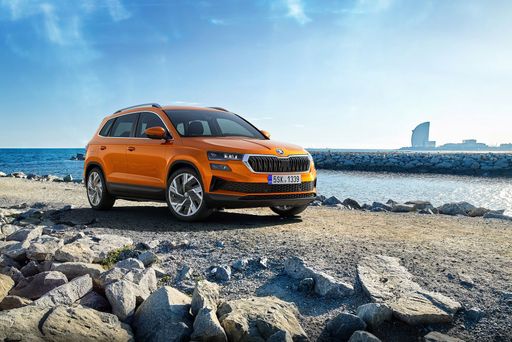 @ Škoda Auto a.s. / Škoda Storyboard
@ Škoda Auto a.s. / Škoda Storyboard
Skoda Karoq
SEAT Ateca
The SEAT Ateca stands out with its dynamic design, perfectly blending style and functionality for urban and rural settings alike. Inside, it offers a spacious and comfortable cabin, complete with advanced technology and intuitive controls that enhance the driving experience. On the road, the Ateca delivers a balanced performance, providing a smooth ride with agile handling that makes it versatile for various driving conditions.
details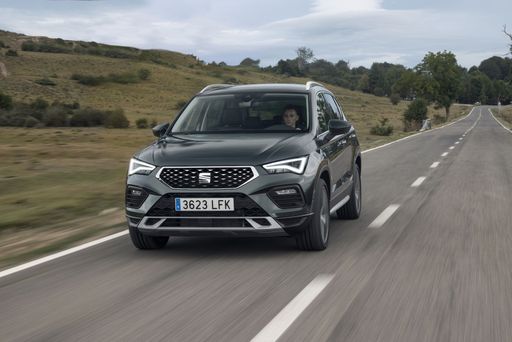 @ SEAT S.A. / SEAT Media Center
@ SEAT S.A. / SEAT Media Center
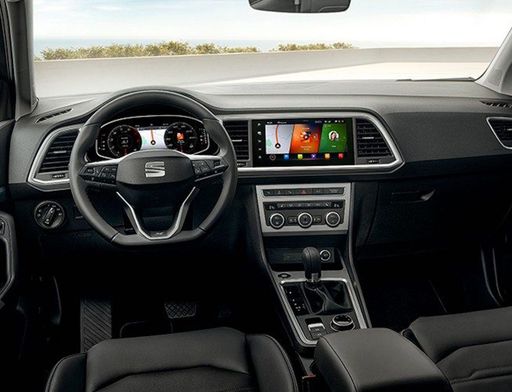 @ SEAT S.A. / SEAT Media Center
@ SEAT S.A. / SEAT Media Center
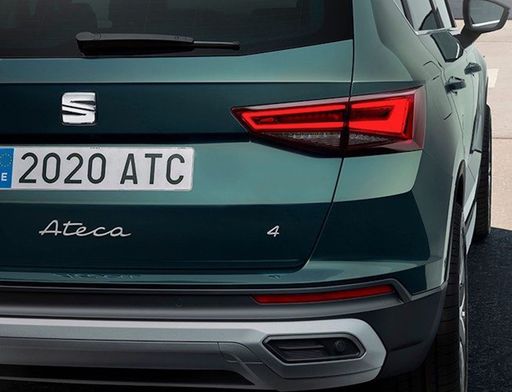 @ SEAT S.A. / SEAT Media Center
@ SEAT S.A. / SEAT Media Center
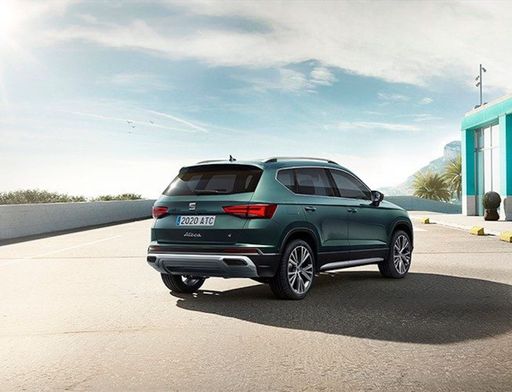 @ SEAT S.A. / SEAT Media Center
@ SEAT S.A. / SEAT Media Center
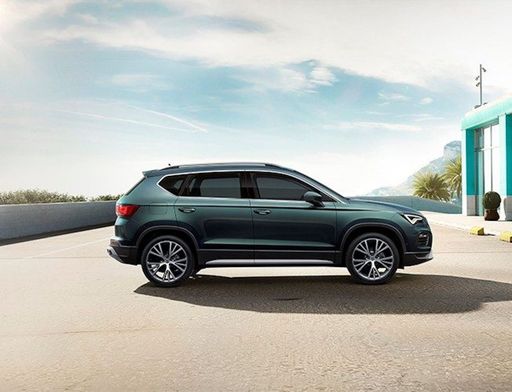 @ SEAT S.A. / SEAT Media Center
@ SEAT S.A. / SEAT Media Center
Skoda Karoq
The Skoda Karoq is a versatile compact SUV that combines practicality with a stylish design. Its interior is spacious and well-appointed, offering a comfortable ride for both driver and passengers. With advanced technology features, it ensures a connected and safe driving experience.
details @ Škoda Auto a.s. / Škoda Storyboard
@ Škoda Auto a.s. / Škoda Storyboard
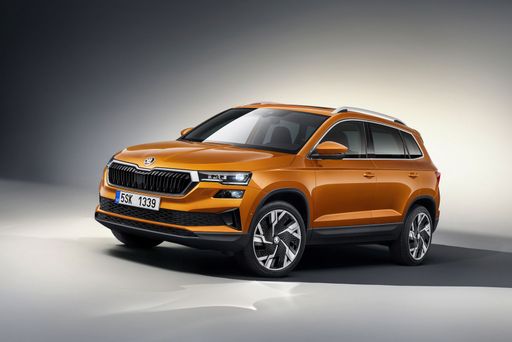 @ Škoda Auto a.s. / Škoda Storyboard
@ Škoda Auto a.s. / Škoda Storyboard
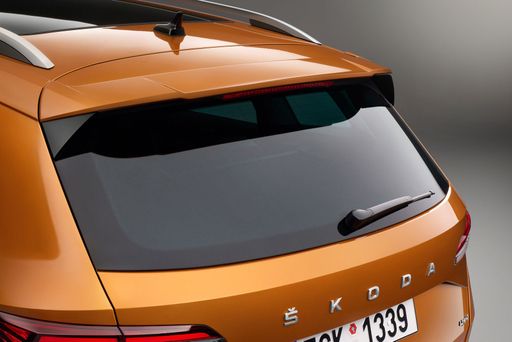 @ Škoda Auto a.s. / Škoda Storyboard
@ Škoda Auto a.s. / Škoda Storyboard
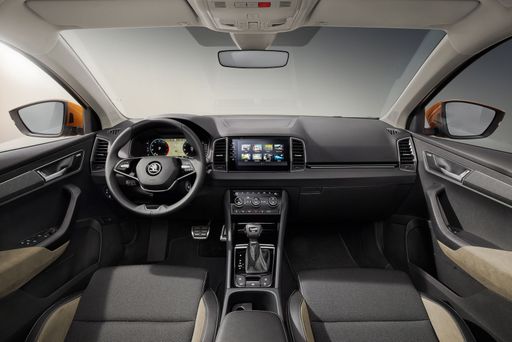 @ Škoda Auto a.s. / Škoda Storyboard
@ Škoda Auto a.s. / Škoda Storyboard
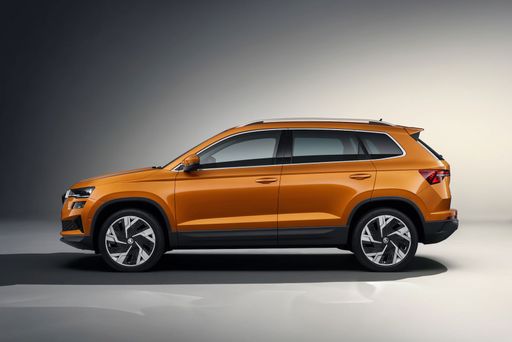 @ Škoda Auto a.s. / Škoda Storyboard
@ Škoda Auto a.s. / Škoda Storyboard
 @ SEAT S.A. / SEAT Media Center
@ SEAT S.A. / SEAT Media Center
|
 @ Škoda Auto a.s. / Škoda Storyboard
@ Škoda Auto a.s. / Škoda Storyboard
|
|
|
|
Costs and Consumption |
|
|---|---|
|
Price
25100 - 36900 £
|
Price
29100 - 41700 £
|
|
Consumption L/100km
4.9 - 6.4 L
|
Consumption L/100km
4.9 - 7.6 L
|
|
Consumption kWh/100km
-
|
Consumption kWh/100km
-
|
|
Electric Range
-
|
Electric Range
-
|
|
Battery Capacity
-
|
Battery Capacity
-
|
|
co2
129 - 144 g/km
|
co2
128 - 173 g/km
|
|
Fuel tank capacity
50 L
|
Fuel tank capacity
50 - 55 L
|
Dimensions and Body |
|
|---|---|
|
Body Type
SUV
|
Body Type
SUV
|
|
Seats
5
|
Seats
5
|
|
Doors
5
|
Doors
5
|
|
Curb weight
1345 - 1514 kg
|
Curb weight
1380 - 1655 kg
|
|
Trunk capacity
510 L
|
Trunk capacity
521 L
|
|
Length
4381 mm
|
Length
4384 - 4390 mm
|
|
Width
1841 mm
|
Width
1841 mm
|
|
Height
1601 mm
|
Height
1624 - 1629 mm
|
|
Max trunk capacity
1604 L
|
Max trunk capacity
1630 L
|
|
Payload
516 - 525 kg
|
Payload
456 - 549 kg
|
Engine and Performance |
|
|---|---|
|
Engine Type
Petrol, Diesel
|
Engine Type
Petrol, Diesel
|
|
Transmission
Manuel, Automatic
|
Transmission
Manuel, Automatic
|
|
Transmission Detail
Manual Gearbox, Dual-Clutch Automatic
|
Transmission Detail
Manual Gearbox, Dual-Clutch Automatic
|
|
Drive Type
Front-Wheel Drive
|
Drive Type
Front-Wheel Drive, All-Wheel Drive
|
|
Power HP
116 - 150 HP
|
Power HP
115 - 190 HP
|
|
Acceleration 0-100km/h
9 - 11 s
|
Acceleration 0-100km/h
7 - 11.2 s
|
|
Max Speed
183 - 202 km/h
|
Max Speed
192 - 221 km/h
|
|
Torque
200 - 360 Nm
|
Torque
200 - 360 Nm
|
|
Number of Cylinders
3 - 4
|
Number of Cylinders
3 - 4
|
|
Power kW
85 - 110 kW
|
Power kW
85 - 140 kW
|
|
Engine capacity
999 - 1968 cm3
|
Engine capacity
999 - 1984 cm3
|
General |
|
|---|---|
|
Model Year
2024 - 2025
|
Model Year
2025
|
|
CO2 Efficiency Class
E, D
|
CO2 Efficiency Class
D, E, F
|
|
Brand
SEAT
|
Brand
Skoda
|
What drive types are available for the SEAT Ateca?
The SEAT Ateca is offered with Front-Wheel Drive.
The prices and data displayed are estimates based on German list prices and may vary by country. This information is not legally binding.
